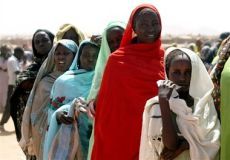Large tracts of Darfur inaccessible – Oxfam
June 11, 2007 (NAIROBI) — Increasing violence in the western Sudanese region of Darfur has cut aid workers’ access to affected civilians to its lowest level since the early days of conflict, the British charity Oxfam said.
 As a result, large parts of rural Darfur were now completely inaccessible for aid agencies. Humanitarian workers and operations, it added, were increasingly being targeted.
As a result, large parts of rural Darfur were now completely inaccessible for aid agencies. Humanitarian workers and operations, it added, were increasingly being targeted.
“Vehicles are being hijacked and robbed, staff assaulted and intimidated while carrying out their work, and offices broken into and looted,” Oxfam noted in a statement on 8 June. “As the armed movements split into ever smaller factions, Darfur has become more lawless and volatile than ever.”
The worsening insecurity had forced many humanitarian agencies to use helicopters. However, these tended to be limited to the larger towns and camps. “In villages and rural areas we are often simply unable to get there,” Oxfam said.
Even inside the camps, it was becoming more insecure. “Armed men have entered the camps to harass civilians and aid workers, steal vehicles and loot equipment – all in broad daylight and without fear of getting caught,” the charity noted.
According to the statement, attacks on civilians had forced more than 80,000 out of their homes in the first two months of 2007. “Many of these people have had to flee for the second, third or even fourth time as they desperately seek refuge and protection,” it said. “Many of the vast camps are already operating at capacity – some are the size of cities and shelter around 100,000 people.”
The charity noted that the massive humanitarian response in Darfur had largely stabilised living conditions in the camps, but warned of a danger that this situation could be reversed if humanitarian access rapidly decreased.
The United Nations Mission in Sudan (UNMIS) said another 300 displaced families had arrived in Um Dhukum [West Darfur] last week. “A very visible consequence of the continued pace of displacement is the swelling population of IDP [internally displaced persons] camps – many of which can no longer absorb new arrivals,” UNMIS spokesman George Somerwill told reporters in the Sudanese capital of Khartoum.
The four-year Darfur conflict started when rebels took up arms against the Sudanese government, accusing it of marginalising the region. The government responded by arming Janjawid militias who are now accused of unleashing terror on the local populations.
According to Oxfam, more than two million people – nearly one in three in Darfur – have had to flee their homes and are sheltering in camps, while another 230,000 refugees are in neighbouring Chad.
“With the conflict showing no sign of ending, many people expect to be stuck in the camps for a long time to come,” it noted. “The main feeling in many of the camps is one of helplessness and frustration – people are trapped here, unable to return home, with limited access to education or economic opportunities.”
(IRIN)
